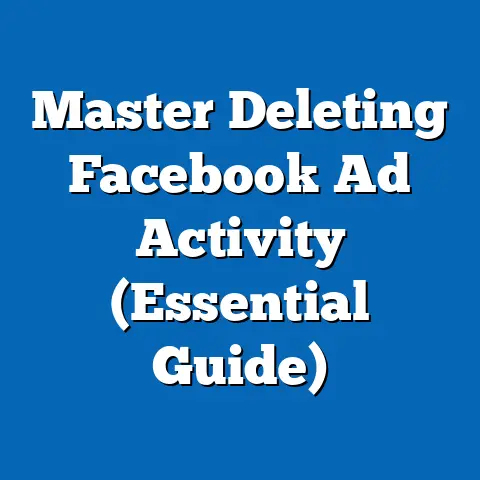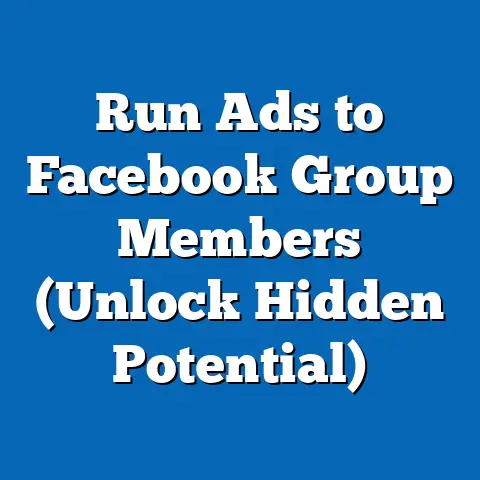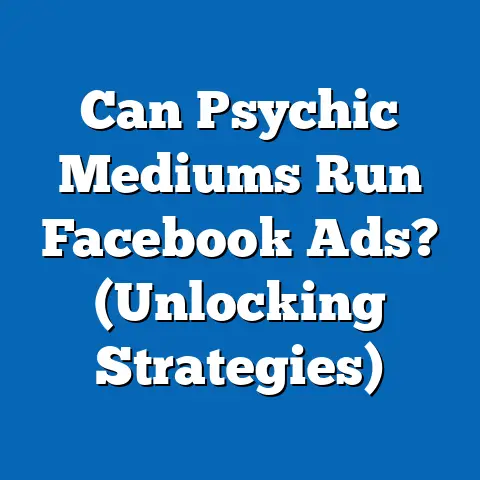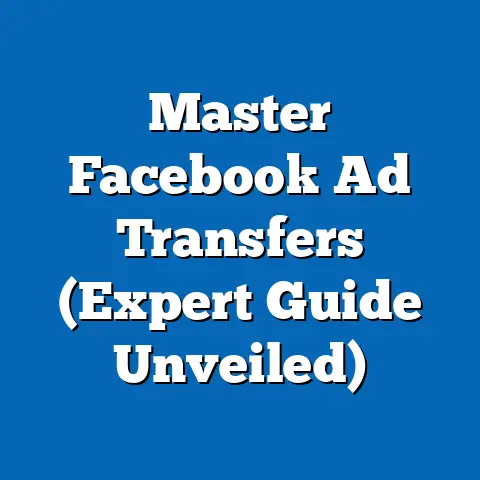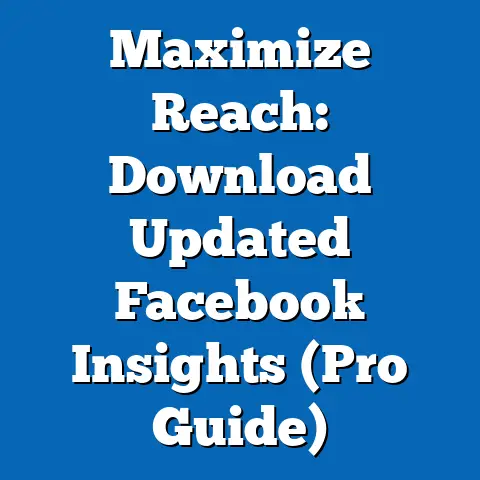Facebook Ads vs Pinterest Ads (Unlocking Growth Potential)
Did you know that Pinterest users are 5 times more likely to make a purchase after seeing a pin than Facebook users after viewing an ad? That statistic blew my mind when I first learned it! It really underscores the importance of understanding where your audience hangs out and tailoring your advertising strategy accordingly. In today’s digital marketing landscape, social media advertising is no longer optional; it’s a necessity. And with platforms like Facebook and Pinterest vying for advertising dollars and consumer attention, it’s crucial to understand which platform offers the best bang for your buck. As someone who’s spent years navigating the ever-changing world of digital advertising, I’m here to break down the key differences, strengths, and weaknesses of Facebook Ads versus Pinterest Ads. My goal? To help you make an informed decision and unlock your brand’s true growth potential.
Overview of Facebook Ads
Facebook Ads, a cornerstone of digital marketing, offers a vast and versatile advertising ecosystem. It’s a platform I’ve spent countless hours on, strategizing, testing, and optimizing campaigns for various clients. Its strength lies in its sheer size and sophisticated targeting capabilities.
User Demographics and Engagement
Facebook boasts billions of active users worldwide, making it a goldmine for reaching a diverse range of audiences. According to Statista, as of Q4 2023, Facebook had nearly 3.05 billion monthly active users. That’s a staggering number! The demographic spread is broad, although it leans slightly towards the 25-34 age group. What I’ve found particularly useful is the platform’s ability to target users based on interests, behaviors, demographics, and even life events. This level of granularity is unparalleled, allowing me to create highly personalized ad experiences.
Ad Formats
Facebook offers a wide array of ad formats to suit different marketing objectives. Here are some of the most popular:
- Image Ads: Simple yet effective, image ads are great for showcasing products or services with compelling visuals. I often use these for retargeting campaigns, reminding users of products they’ve previously viewed on a website.
- Video Ads: Video is king in the digital world, and Facebook video ads are no exception. They’re perfect for storytelling, product demos, or sharing customer testimonials. I’ve seen video ads significantly boost engagement rates compared to static images.
- Carousel Ads: These allow you to showcase multiple images or videos in a single ad unit. I’ve used carousel ads effectively to highlight different features of a product or to tell a story in a sequential manner.
- Collection Ads: Designed for e-commerce, collection ads allow users to browse and purchase products directly from the ad. I’ve found these particularly effective for driving sales and reducing friction in the purchasing process.
- Lead Ads: These ads are designed to collect leads directly on the Facebook platform. They’re great for building email lists or gathering information for sales outreach. I’ve used lead ads successfully to generate qualified leads for various businesses.
Targeting Options
This is where Facebook truly shines. The platform offers a wealth of targeting options, allowing you to reach specific audiences with laser precision. Here are some of the most powerful:
- Audience Segmentation: Target users based on demographics, interests, behaviors, and connections. I use this to create highly specific audience segments based on my client’s ideal customer profiles.
- Retargeting: Show ads to users who have previously interacted with your website, app, or Facebook page. Retargeting is incredibly effective for driving conversions, as you’re reaching users who are already familiar with your brand. I’ve consistently seen retargeting campaigns outperform other types of campaigns in terms of ROI.
- Custom Audiences: Upload your own customer data (e.g., email lists, phone numbers) to create custom audiences. This allows you to target your existing customers with personalized ads. I’ve used custom audiences to promote new products or services to existing customers, resulting in high conversion rates.
- Lookalike Audiences: Create audiences that are similar to your existing customers or website visitors. This is a great way to expand your reach and find new customers who are likely to be interested in your products or services. I’ve used lookalike audiences successfully to scale my client’s advertising campaigns.
Advantages of Facebook Ads
- Extensive Reach: Access to billions of users worldwide.
- Robust Analytics: Detailed data on ad performance, audience demographics, and user behavior.
- Integration with Instagram: Seamlessly run ads on both Facebook and Instagram from a single platform.
- Advanced Targeting: Unparalleled ability to target specific audiences based on various criteria.
Takeaway: Facebook Ads offers unparalleled reach and targeting capabilities, making it a powerful tool for businesses of all sizes.
Overview of Pinterest Ads
Pinterest Ads offers a unique advertising experience centered around visual discovery and inspiration. It’s a platform I’ve grown to appreciate for its distinct user base and its ability to influence purchasing decisions.
User Demographics and Engagement
Pinterest’s user base is primarily female, with a strong interest in home décor, fashion, DIY projects, and recipes. According to Pinterest, over 80% of their users are female. This makes it an ideal platform for businesses targeting women. What I’ve found particularly interesting is that Pinterest users are often in a planning or discovery mindset, actively searching for ideas and inspiration. This makes them more receptive to advertising that aligns with their interests.
Ad Formats
Pinterest offers a variety of ad formats designed to capture users’ attention and drive engagement. Here are some of the most popular:
- Promoted Pins: These are regular pins that advertisers pay to promote. They appear in users’ feeds and search results, blending seamlessly with organic content. I often use promoted pins to drive traffic to my client’s websites or to promote specific products or services.
- Video Pins: Video pins are a great way to showcase products or services in a visually engaging manner. They can be used to tell stories, demonstrate product features, or share customer testimonials. I’ve found video pins particularly effective for driving brand awareness and engagement.
- Shopping Ads: These ads allow users to purchase products directly from the Pinterest platform. They’re ideal for e-commerce businesses looking to drive sales and reduce friction in the purchasing process. I’ve seen shopping ads significantly boost conversion rates for my e-commerce clients.
- Carousel Ads: Similar to Facebook carousel ads, these allow you to showcase multiple images or videos in a single ad unit. I’ve used carousel ads effectively to highlight different features of a product or to tell a story in a sequential manner.
Targeting Capabilities
While Pinterest’s targeting options aren’t as granular as Facebook’s, they are still quite powerful. Here are some of the key targeting capabilities:
- Interest Targeting: Target users based on their interests and hobbies. This is a great way to reach users who are actively searching for ideas and inspiration in your niche. I use interest targeting to reach users who are likely to be interested in my client’s products or services.
- Keyword Targeting: Target users based on the keywords they’re searching for on Pinterest. This is a great way to reach users who are actively looking for specific products or services. I use keyword targeting to reach users who are likely to be ready to make a purchase.
- Audience Targeting: Target users based on their demographics, location, and device. This allows you to refine your targeting and reach specific segments of the Pinterest user base. I use audience targeting to ensure that my ads are reaching the right people.
- Actalike Audiences: Similar to Facebook’s lookalike audiences, these allow you to create audiences that are similar to your existing customers or website visitors. This is a great way to expand your reach and find new customers who are likely to be interested in your products or services. I’ve used actalike audiences successfully to scale my client’s advertising campaigns.
Strengths of Pinterest Ads
- Visual-Centric Approach: Capitalizes on the power of visual content to capture users’ attention.
- Influence on Purchasing Decisions: Pinterest users are often in a planning or discovery mindset, making them more receptive to advertising.
- High Engagement Rates: Pinterest users are highly engaged with the platform, spending time browsing and saving pins.
- Strong for Certain Niches: Particularly effective for businesses in the home décor, fashion, DIY, and food industries.
Takeaway: Pinterest Ads offers a unique advertising experience centered around visual discovery and inspiration, making it a powerful tool for businesses targeting a visually-oriented audience.
Comparing Advertising Objectives
Choosing between Facebook and Pinterest Ads isn’t just about the platform itself; it’s about aligning your advertising objectives with the strengths of each platform. I’ve learned that a clear understanding of your goals is essential for maximizing your ROI.
Facebook: Brand Awareness, Lead Generation, and Conversion
Facebook excels at driving brand awareness, generating leads, and driving conversions. Its vast reach and sophisticated targeting capabilities make it an ideal platform for reaching a broad audience and delivering personalized ad experiences.
- Brand Awareness: Facebook’s reach allows you to expose your brand to a large audience, increasing brand recognition and recall. I’ve used Facebook brand awareness campaigns to introduce new brands to the market and to build brand equity for existing brands.
- Lead Generation: Facebook’s lead ads make it easy to collect leads directly on the platform. I’ve used lead ads successfully to generate qualified leads for various businesses, including those in the real estate, insurance, and education industries.
- Conversion: Facebook’s advanced targeting and retargeting capabilities make it an ideal platform for driving conversions. I’ve used Facebook conversion campaigns to drive sales, generate sign-ups, and encourage app downloads.
Pinterest: Driving Traffic, Enhancing Visibility, and Fostering Discovery
Pinterest shines when it comes to driving traffic to websites, enhancing brand visibility, and fostering discovery. Its visual-centric approach and its user base’s planning mindset make it an ideal platform for inspiring users and driving them to take action.
- Driving Traffic: Pinterest’s promoted pins can drive significant traffic to your website. I’ve used promoted pins successfully to drive traffic to my client’s websites, resulting in increased brand awareness and sales.
- Enhancing Visibility: Pinterest’s visual nature allows you to showcase your brand in a visually appealing manner, enhancing brand visibility and recognition. I’ve used Pinterest to create visually stunning brand profiles that attract followers and drive engagement.
- Fostering Discovery: Pinterest’s planning mindset makes it an ideal platform for fostering discovery. Users are actively searching for ideas and inspiration, making them more receptive to advertising that aligns with their interests. I’ve used Pinterest to introduce new products and services to users who are actively searching for solutions in my client’s niche.
Use Cases and Statistics
- Facebook: A study by HubSpot found that Facebook ads have an average conversion rate of 9.21%. This highlights Facebook’s effectiveness in driving conversions.
- Pinterest: A study by Pinterest found that 87% of Pinterest users have purchased a product because of Pinterest. This underscores Pinterest’s influence on purchasing decisions.
Takeaway: Facebook is ideal for brand awareness, lead generation, and conversion, while Pinterest excels at driving traffic, enhancing visibility, and fostering discovery.
Cost Analysis and ROI
Understanding the cost implications and potential return on investment is crucial for making informed advertising decisions. I’ve found that a detailed cost analysis can help you allocate your budget effectively and maximize your ROI.
Average Costs for Facebook Ads
The cost of Facebook Ads can vary depending on several factors, including:
- Target Audience: Highly targeted audiences tend to be more expensive to reach.
- Ad Placement: Ads placed in more prominent locations (e.g., Facebook News Feed) tend to be more expensive.
- Ad Format: Video ads tend to be more expensive than image ads.
- Bidding Strategy: Different bidding strategies (e.g., cost per click, cost per impression) can impact your overall costs.
According to WebFX, the average cost-per-click (CPC) for Facebook Ads is around \$0.97, and the average cost-per-impression (CPM) is around \$7.19.
Average Costs for Pinterest Ads
The cost of Pinterest Ads can also vary depending on several factors, including:
- Target Audience: Similar to Facebook, highly targeted audiences tend to be more expensive to reach.
- Ad Placement: Ads placed in more prominent locations (e.g., search results) tend to be more expensive.
- Ad Format: Video pins tend to be more expensive than promoted pins.
- Bidding Strategy: Similar to Facebook, different bidding strategies can impact your overall costs.
According to Shopify, the average cost-per-click (CPC) for Pinterest Ads is around \$0.10 to \$1.50, and the average cost-per-impression (CPM) is around \$2.00 to \$5.00.
ROI Analysis
While the costs of Facebook Ads may be higher than Pinterest Ads, the potential ROI can also be greater. Facebook’s advanced targeting and retargeting capabilities make it an ideal platform for driving conversions and generating a high ROI. However, Pinterest Ads can also offer a strong ROI, particularly for businesses in visually-oriented industries.
Value Proposition
Ultimately, the value proposition for advertisers depends on their specific business goals and target audience. If you’re looking to reach a broad audience and drive conversions, Facebook Ads may be the better choice. If you’re looking to target a visually-oriented audience and inspire them to take action, Pinterest Ads may be the better choice.
Takeaway: A detailed cost analysis and ROI analysis can help you allocate your budget effectively and maximize your return on investment.
Best Practices for Each Platform
To truly succeed with Facebook and Pinterest Ads, it’s essential to follow best practices tailored to each platform. I’ve learned that a one-size-fits-all approach simply doesn’t work.
Facebook Ads Best Practices
- Ad Design: Use high-quality images and videos that are visually appealing and relevant to your target audience. I always recommend testing different ad creatives to see what resonates best with your audience.
- Timing: Schedule your ads to run during peak hours when your target audience is most active on Facebook. I use Facebook’s ad scheduling feature to ensure that my ads are reaching the right people at the right time.
- Audience Engagement: Encourage users to engage with your ads by asking questions, running contests, or offering incentives. I’ve found that engaging with users in the comments section can significantly boost brand loyalty and advocacy.
- A/B Testing: Continuously test different ad elements (e.g., headlines, images, calls to action) to optimize your ad performance. A/B testing is crucial for identifying what works best for your audience and for improving your overall ROI. I use Facebook’s A/B testing feature to test different ad variations and identify the winning combinations.
Pinterest Ads Best Practices
- Visual Appeal: Create visually stunning pins that capture users’ attention and inspire them to take action. I always recommend using high-resolution images and videos that are well-lit and professionally produced.
- SEO Optimization: Optimize your pins for search by using relevant keywords in your pin titles and descriptions. This will help your pins appear in search results and attract more traffic to your website. I use Pinterest’s keyword research tool to identify the most relevant keywords for my pins.
- Trend Leveraging: Take advantage of trending topics and seasonal themes to create pins that are timely and relevant. This will help you capture users’ attention and drive engagement. I use Pinterest’s trending topics feature to identify popular topics and create pins that align with those trends.
Successful Campaign Examples
- Facebook: Nike’s “Just Do It” campaign is a great example of a successful Facebook campaign that drove brand awareness and engagement.
- Pinterest: Airbnb’s Pinterest profile is a great example of a successful Pinterest profile that showcases their brand in a visually appealing manner.
Takeaway: Following best practices tailored to each platform can significantly improve your ad performance and maximize your ROI.
Future Trends in Advertising
The world of social media advertising is constantly evolving, and it’s essential to stay ahead of the curve. I’m always keeping an eye on emerging trends and technologies that could impact the way we advertise on platforms like Facebook and Pinterest.
The Rise of Video Content and Live Streaming
Video content is becoming increasingly popular on social media, and live streaming is gaining traction. Advertisers can leverage these trends by creating engaging video ads and hosting live streaming events to connect with their audience in real-time.
Integration of AR and AI
Augmented reality (AR) and artificial intelligence (AI) are transforming the advertising landscape. AR allows advertisers to create immersive ad experiences that engage users in new and exciting ways. AI can be used to personalize ads, optimize ad targeting, and automate ad management tasks.
Changes in User Behavior
User behavior is constantly evolving, and advertisers need to adapt to these shifts. For example, users are increasingly using mobile devices to access social media, so it’s essential to optimize your ads for mobile viewing. Users are also becoming more discerning about the ads they see, so it’s crucial to create ads that are relevant, engaging, and non-intrusive.
Takeaway: Staying ahead of emerging trends and adapting to changes in user behavior is essential for success in the ever-evolving world of social media advertising.
Conclusion
In conclusion, both Facebook Ads and Pinterest Ads offer unique strengths and weaknesses. Facebook boasts unparalleled reach and sophisticated targeting capabilities, making it ideal for brand awareness, lead generation, and conversion. Pinterest, on the other hand, shines when it comes to driving traffic, enhancing visibility, and fostering discovery, particularly for businesses in visually-oriented industries.
The key to success lies in understanding your specific business goals, target audience, and marketing strategies. Consider your objectives, analyze your audience’s behavior, and choose the platform that aligns best with your needs. Don’t be afraid to experiment and test different approaches to see what works best for your brand.
With the right strategy, which platform will you choose to unlock your brand’s growth potential? The answer, as I’ve learned time and time again, is the one that best serves your audience and helps you achieve your unique business goals.


